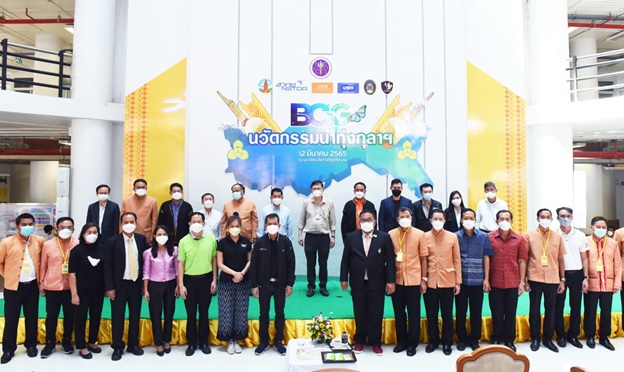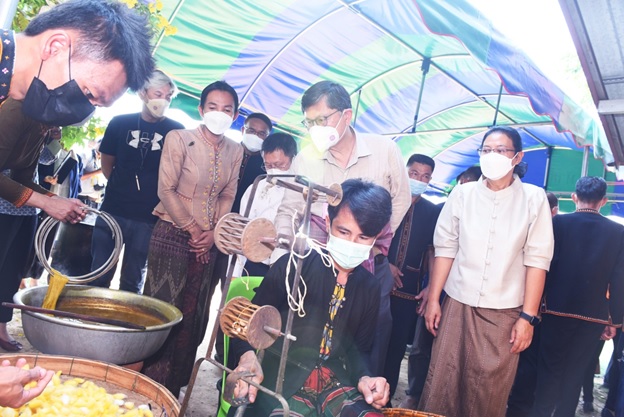On 11-13 March 2022, a number of events were held in Sisaket to promote science, technology and innovation (STI) for Thung Kula Ronghai - a region in northeastern Thailand. Attending these events were Prof. Dr. Anek Laothamatas, Minister of Higher Education, Science, Research and Innovation (MHESI) and leaders of STI organizations, including the Office of MHESI Permanent Secretary, the Office of National Higher Education Science Research and Innovation Policy Council (NXPO), the National Research Council of Thailand (NRCT) and NSTDA.

STI for Thung Kula Ronghai is part of the Bio-Circular-Green Economy (BCG) Action Plan aimed at employing STI to improve the quality of life and income of people in five provinces, namely Sisaket, Roi Et, Maha Sarakham, Yasothon and Surin. NSTDA has showcased its work in applying its technologies and innovations to textile and farming sectors in this region.
Innovations to create value to traditional textile
Sisaket is well-known for Benjasri handwoven fabric with intricate pattern reflecting the rich culture. Two innovations have been brought to strengthen the production of this unique fabric. ENZease is a nature-based enzyme for one-step biodesizing and bioscouring. The duo-activity enzyme makes the operation more cost effective and eco-friendly. Nanotechnology has potential to provide new properties and functionalities to the fabric, including softness, UV protective finishes, antibacterial finishes, as well as perfume finishes. With nanoencapsulation, fragrance of Sisaket’s provincial flower, Dok Lamduan, is added to create a unique identity to Benjasi fabric.

In addition, NSTDA has been working with Sisaket Community Development Office introducing technology and innovation to silk weaving villagers in Baan Hua Change Village. Design experts were brought in to help the villagers with the design of fabric pattern and clothing products. Mechanized loom has been developed for villagers to increase their productivity. To preserve the cultural heritage, a digital platform Navanurak developed by NECTEC-NSTDA was introduced for archiving fabric patterns.
Improve rice farmers’ income with mung bean cultivation
NSTDA in collaboration with Kasetsart University developed new mung bean cultivars with high yield (120-150 kg/rai) and resistance to powdery mildew and Cercospora leaf spot. These cultivars were introduced as a post-rice crop, along with knowledge on farm and disease management, to rice farmers in Roi Et and Sirin in 2020. A total of 100 farmers participated in the project, corresponding to a cultivating area of 500 rai (80 ha). Farmers were able to earn additional income of THB 2,600-3,300 per one rai of cultivating land. These farmers are connected to major mung bean buyers in food processing industry such as Thai Wah Public Company Limited and Kittitat Company Limited.

For 2021/2022 workplan, NSTDA is collaborating with Surindra Rajabhat University, Rajabhat Maha Sarakham University, Mahasarakham University, Rajamangala University of Technology Isan and Sisaket Agriculture Office to expand the project. A total of 317 farmers, equivalent to 2,161 rai (345 ha) planting are, have signed up. The production of 2021/2022 cropping season is expected to be 324 tons, creating a THB 7.13 million economic impact to this region.
